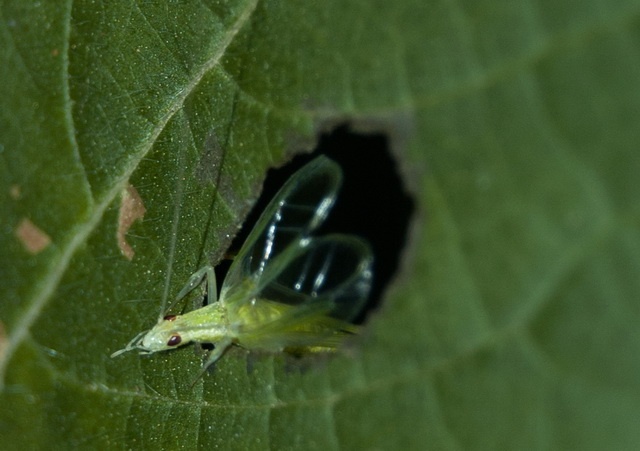Small tree cricket calls from a window
Those that are small must be smart. At least that applies to tree crickets. Males with a softer call than others have an effective strategy to amplify their sound, as Rittik Deb and colleagues show.
Small crickets face a problem. To attract females, cricket males raise their forewings and rub them together. The forewings are leathery and provided with a comb. The rubbing causes them to vibrate, and as vibrating membranes, they produce sound waves: the familiar chirping. But at the wing edges, the sound waves are attenuated, softening the sound. Especially for small species, with small wings, that effect is significant. For instance for tree crickets (Oecanthus species), with wings only about one centimeter long.
Small and soft calling males of tree cricket Oecanthus henryi, which lives in India, have a unique method to amplify their sound, Rittik Deb and colleagues report: they turn a leaf into a sound amplifier.
Pear-shaped hole
The chirping noise is extinguished at the wing edges because waves at the front and back side are in opposite phase. That is because when air is compressed by the vibrating wings at the front side (creating a wave peak), it expands at the back (wave trough) and vice versa. At the edges, waves cancel each other out because of these opposite phase, resulting in a softer sound.
Tree cricket males can prevent this by separating the waves from the front and back side with a baffle. They do this by cutting a small window in a leaf and taking place in it to sing, with the head directed to one side, the abdomen to the other, and the raised forewings perpendicular to the body, in the plane of the leaf.
Previously, the researchers had shown that tree crickets can create a nearly perfect window in one go. They make such hole only in larger leaves of their host plant, Hyptis suavevolens. That makes sense, because large leaves produce a clear effect. The best place for the hole is in the center, but there the midrib runs. The leaf would wither when the tree crickets pierced it. So, they cut the hole close to the center, next to the midrib. And they make the hole pear-shaped, fitting the male with raised forewings, with the edges of wings and window close to each other.
The baffle is a good sound amplifier. The call is louder than it would be without it. For females, this is more attractive. In addition, the sound travels further, reaching more females.
More sperm
Yet not all tree cricket males take the effort to make such sound amplifier. Now, the researchers show that mainly the smaller ones with a soft sound do it, and explain why they do it.
By singing with a self-made baffle, small and soft calling males increase females’ attendance, as expected. With this sound amplifier, they may attract about six times as many females per night as without baffling, the researchers calculated. That is a considerable gain. Large and loud calling males can attract more females with a baffle too. But it doesn’t help them much, because even without sound amplification, they get as many mates as they can handle. They do not need to attract more females.
Large and loud males therefore call in the standard way: from the edge of a leaf. But other males make a window to amplify the sound of their call. This makes them appear larger than they really are, and females are misled. They mate longer with louder calling males – either large males or small, baffling ones – so that these males can transfer more sperm. By making a baffle, small and soft calling males increase their reproductive success, which would otherwise be quite low.
Willy van Strien
Photo: Oecanthus henryi. ©Rittik Deb
Sources:
Deb, R., S. Modak & R. Balakrishnan, 2020. Baffling: a condition-dependent alternative mate attraction strategy using self-made tools in tree crickets. Proceedings of the Royal Society B 287: 20202229. Doi: 10.1098/rspb.2020.2229
Mhatre, N., R. Malkin, R. Deb, R. Balakrishnan & D. Robert, 2017. Tree crickets optimize the acoustics of baffles to exaggerate their mate-attraction signal. eLife 6: e32763. Doi: 10.7554/eLife.32763
